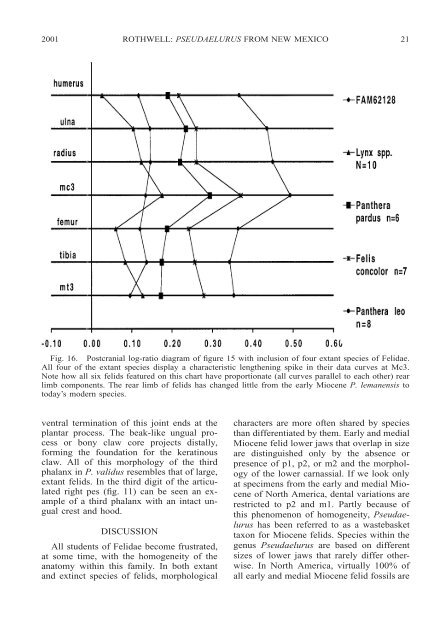A Partial Skeleton of Pseudaelurus (Carnivora: Felidae) - American ...
A Partial Skeleton of Pseudaelurus (Carnivora: Felidae) - American ...
A Partial Skeleton of Pseudaelurus (Carnivora: Felidae) - American ...
Create successful ePaper yourself
Turn your PDF publications into a flip-book with our unique Google optimized e-Paper software.
2001 ROTHWELL: PSEUDAELURUS FROM NEW MEXICO<br />
21<br />
Fig. 16. Postcranial log-ratio diagram <strong>of</strong> figure 15 with inclusion <strong>of</strong> four extant species <strong>of</strong> <strong>Felidae</strong>.<br />
All four <strong>of</strong> the extant species display a characteristic lengthening spike in their data curves at Mc3.<br />
Note how all six felids featured on this chart have proportionate (all curves parallel to each other) rear<br />
limb components. The rear limb <strong>of</strong> felids has changed little from the early Miocene P. lemanensis to<br />
today’s modern species.<br />
ventral termination <strong>of</strong> this joint ends at the<br />
plantar process. The beak-like ungual process<br />
or bony claw core projects distally,<br />
forming the foundation for the keratinous<br />
claw. All <strong>of</strong> this morphology <strong>of</strong> the third<br />
phalanx in P. validus resembles that <strong>of</strong> large,<br />
extant felids. In the third digit <strong>of</strong> the articulated<br />
right pes (fig. 11) can be seen an example<br />
<strong>of</strong> a third phalanx with an intact ungual<br />
crest and hood.<br />
DISCUSSION<br />
All students <strong>of</strong> <strong>Felidae</strong> become frustrated,<br />
at some time, with the homogeneity <strong>of</strong> the<br />
anatomy within this family. In both extant<br />
and extinct species <strong>of</strong> felids, morphological<br />
characters are more <strong>of</strong>ten shared by species<br />
than differentiated by them. Early and medial<br />
Miocene felid lower jaws that overlap in size<br />
are distinguished only by the absence or<br />
presence <strong>of</strong> p1, p2, or m2 and the morphology<br />
<strong>of</strong> the lower carnassial. If we look only<br />
at specimens from the early and medial Miocene<br />
<strong>of</strong> North America, dental variations are<br />
restricted to p2 and m1. Partly because <strong>of</strong><br />
this phenomenon <strong>of</strong> homogeneity, <strong>Pseudaelurus</strong><br />
has been referred to as a wastebasket<br />
taxon for Miocene felids. Species within the<br />
genus <strong>Pseudaelurus</strong> are based on different<br />
sizes <strong>of</strong> lower jaws that rarely differ otherwise.<br />
In North America, virtually 100% <strong>of</strong><br />
all early and medial Miocene felid fossils are

















